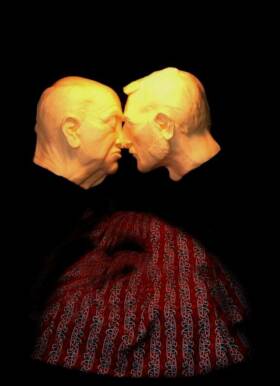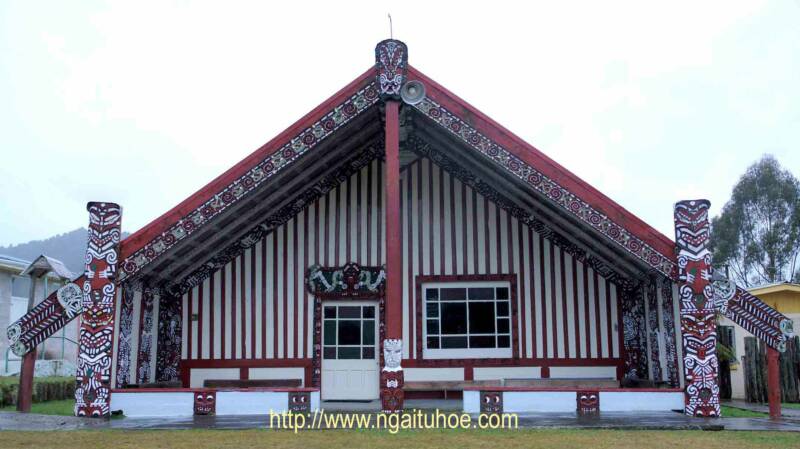Marae Protocol Procedures
(Kawa)
1 The Beginning of a Marae meeting or gathering on a Marae in Tuhoe starts as follows...

 The manuhiri (Guests/visitors) wait at the gate
The manuhiri (Guests/visitors) wait at the gate

 entrance (tomokanga) of the marae with women
entrance (tomokanga) of the marae with women

 and children flanked closely by the men. This
and children flanked closely by the men. This

 indicates to tangata whenua (hosts) they are ready.
indicates to tangata whenua (hosts) they are ready.

 The tangata whenua group at the side of the
The tangata whenua group at the side of the

 marae paepae (Marae Forecourt). As many
marae paepae (Marae Forecourt). As many

 of the tangata whenua as possible would do this
of the tangata whenua as possible would do this

 as an expression of their welcome.
as an expression of their welcome.
2. Karanga (call)

 A lady from the host side calls in the traditional maner indicating to guests to move
A lady from the host side calls in the traditional maner indicating to guests to move 












 forward on to the marae paepae. This is answered by a woman's response within the
forward on to the marae paepae. This is answered by a woman's response within the 




 guests entourage a call of welcome and acknowledgment. It is also an identification call
guests entourage a call of welcome and acknowledgment. It is also an identification call 

 from the guests indicating the groups origin. At a tangi (funeral) where groups
from the guests indicating the groups origin. At a tangi (funeral) where groups

 follow one another this point becomes more crucial.
follow one another this point becomes more crucial.
3 Manuhiri Movement

 While the host will stand during the karanga (traditional welcome calling), the manuhiri
While the host will stand during the karanga (traditional welcome calling), the manuhiri 


 move forward to the centre of the marae paepae (about 10-20 metres) in front of the
move forward to the centre of the marae paepae (about 10-20 metres) in front of the

 meeting house. Before the welcome can proceed, the manuhiri must have the tapu (or
meeting house. Before the welcome can proceed, the manuhiri must have the tapu (or 






 alien element) in them removed or lifted by tradition spiritual prayer.
alien element) in them removed or lifted by tradition spiritual prayer.
4 Acknowledgment to those who have passed on (Our Dead)

 The manuhiri have entered the paepae,
The manuhiri have entered the paepae,

 there is a slight pause usually with the
there is a slight pause usually with the

 tangata whenua with heads bowed for
tangata whenua with heads bowed for

 two or three minutes in remembrance.
two or three minutes in remembrance.

 Immediately after, the tangata whenua
Immediately after, the tangata whenua

 will sit and at a given sign, the manuhiri
will sit and at a given sign, the manuhiri

 move to take up the seats provided on
move to take up the seats provided on

 the left hand side of the marae paepae
the left hand side of the marae paepae

 with the speakers sitting in the front row
with the speakers sitting in the front row

 seats. Woman and children to the back.
seats. Woman and children to the back.

 In Tuhoe it is only men who may speak
In Tuhoe it is only men who may speak

 and sit in this front row of seats.
and sit in this front row of seats.
5. Whai korero procedure. There are two methods by which speakers interact.
- Tau utuutu - speakers alternate, with the tangata whenua beginning and finally ending after the speakers have alternated. The Waikato tribe including Ngati Raukawa use this method.
- Paeke - All tangata whenua speak first followed by all manuhiri speakers. The very last speaker is always the tangata whenua. This is normally the method used in the Ngapuhi, Tuhoe and East Coast tribal areas. In both methods the tangata whenua will have the final say outlining the next procedure ending with the invitation to the manuhiri to come forward and meet the local by hongi. The hongi is a sacred process which involves pressing noses and foreheads together either once or twice to acknoweldge friendship and unity between two people as demonstrated here at this point
6 Waikorero Format
- While there are specific variations there is a common pattern. The following is a pattern of a whaikorero of a visiting speaker. The host speaker follows the same format except he rarely addresses the house but emphasises a warm welcome.
- Tauparapara - Introductory salutation, a chant, which can be for identification or an uplifting statement or a mood setting stature to arrest the listeners. It indicates a wish to speak,
For example:
 Ka tangi te titi
Ka tangi te titi

 The Titi is calling
The Titi is calling
 Ka tangi te kaka
Ka tangi te kaka
 The Kaka is calling
The Kaka is calling
 Ka tangi hoki ahau
Ka tangi hoki ahau and I wish to call
and I wish to call
 Tihei Mauriora
Tihei Mauriora
 behold for there is life
behold for there is life
- Mihi to the marae, the house and those present - The marae and the house is personified to the extent that the visiting speaker may connect himself with the hosts through their genealogy or common interest
For example:
 Te whare tipuna e tu nei
Te whare tipuna e tu nei The house standing there
The house standing there
 Te Marae e takoto nei
Te Marae e takoto nei
 The marae lying here
The marae lying here
 Tena korua
Tena korua

 greetings to you all
greetings to you all
 Nga hau e wha
Nga hau e wha

 To the four winds
To the four winds
 Nga iwi e tau nei
Nga iwi e tau nei
 People gathered here
People gathered here
 Tena koutou katoa
Tena koutou katoa
 Greetings to you all
Greetings to you all
- Mihi to the Dead (hunga mate) - Traditionaly amongst Maori there is an ever mixed blend of differences between life and death - a continuous whole, a sequential movement in which the dead are remembered, greeted and mourned by the hunga ora (the living).
For example
 Nga mate aitua o koutou
Nga mate aitua o koutou  The dead the afflicted both yours and ours
The dead the afflicted both yours and ours
 Ka tangihia e tatou i tenei wa
Ka tangihia e tatou i tenei wa We lament for them at this time
We lament for them at this time
 Haere, haere, haere.
Haere, haere, haere.
 Farewell, farewell, farewell
Farewell, farewell, farewell
- Te Take (The reason for gathering) - Mention is now made of the reason for the visit.
For example:
 Karanga mai ia matou e wha nei I nga taonga o nga tupuna
Karanga mai ia matou e wha nei I nga taonga o nga tupuna
 Call us to seek the treasures of our forebears
Call us to seek the treasures of our forebears
- Te Whakamutunga (The Conclusion) - The conclusion finishes with a song (a waiata). The mana of the speaker is always enhanced if his speech is backed by a suitable song or chant.
- Women and men accompany a speaker in singing a waiata.
A speaker may after the waiata finally summarise the greeting to all and indicate the next action.
For example:
 No reira, ta piti hono tatai hono Therefore depths to depths
No reira, ta piti hono tatai hono Therefore depths to depths
 Te hunga mate ki te hunga mate To blessed death to blesses death
Te hunga mate ki te hunga mate To blessed death to blesses death
 Te hunga ora ki te hunga ora
Te hunga ora ki te hunga ora  To blessed life to blessed life
To blessed life to blessed life
 Tena koutou katoa
Tena koutou katoa

 Greetings to you all
Greetings to you all
* * * * * * * * * * *
The following is a Typical Ngai Tuhoe Whai Korero most speakers
use as their maiden Whai Korero or speech Delivery
* * * * * * * * * * *
TE MIHI TURUA
Tauparapara
The Opening Part of your Delivery





 Te mihi kia ihowa ona mano kia ihu Karaiti
Te mihi kia ihowa ona mano kia ihu Karaiti





 Ki te Wairua Tapu i homai nei i te mataura
Ki te Wairua Tapu i homai nei i te mataura





 Ki tatau ki te tangata ki te hunga ora
Ki tatau ki te tangata ki te hunga ora





 Kororia ki tona ingoa tapu
Kororia ki tona ingoa tapu
- - - -
The Main Part of your delivery





 Te mihi ki te Whare tipuna e tu nei
Te mihi ki te Whare tipuna e tu nei





 Kua korero tia ratou me nga tekoteko e tu nei
Kua korero tia ratou me nga tekoteko e tu nei





 Kia Papa-Tua-Nuku e takoto nei
Kia Papa-Tua-Nuku e takoto nei





 Te hikoi a o tatau tipuna
Te hikoi a o tatau tipuna





 Kia koe e Rangi-te-Po e titiro mai nei
Kia koe e Rangi-te-Po e titiro mai nei





 Ki nga Aitua kua whetu rangatia kua haere ki te a po
Ki nga Aitua kua whetu rangatia kua haere ki te a po





 Kua hoki ki te tuturu kainga mo o tatau Maori e korero tia nei
Kua hoki ki te tuturu kainga mo o tatau Maori e korero tia nei





 No reira ki te hunga mate
No reira ki te hunga mate





 Te hunga ora ki te hunga ora
Te hunga ora ki te hunga ora





 Kua tu tangata katoa tatau
Kua tu tangata katoa tatau
- - - -
At this point you state who you are and where your from
in the form of your whakapapa , family or Iwi link





 Ko Maungapohatu te Maunga
Ko Maungapohatu te Maunga





 Ko Tamaikaimoana - a me Ngaiti Raka nga Hapu
Ko Tamaikaimoana - a me Ngaiti Raka nga Hapu
Followed by the reason your there
Ladies & Gentleman
We are here today
because..............
Followed by a gift to the Tangat Whenua or Koha
you place on the ground for your host to accept
Ladies & Gentle
we/ I acknowledge your hospitality
and offer to you our Koha
Followed by a Waiata (song)
you sing
After the end of your song you return the floor
as it were back to the host s or next speaker
Kua mutu nga paku korero
Ko au tenei e mihi atu kia koutou
Kua huri
"My speech ends I thank you and
I return the floor back to you"
* * * * * * * *
At this point if you are the last speaker
the hosts will usher you on
to meet everyone
* * * * * * * *
End
7. Presenting a koha (money gifts)
- Normally the last speaker on the manuhiri side presents the koha, A koha is an amount of money collected from the manuhiri in respect to the tangata whenua for their impending hospitality. The koha helps off set costs against food, electricity, and Marae development for future events. It also helps to maintain Marae upkeep.
- It is normally the prerogative of the manuhiri to decide how much to give and an assessment can be made based on the number of days or even hours they are staying.
- The koha is always laid down on the ground between the manuhiri and tangata whenua on the marae and the giver slowly backs away back to his place with his people. A local person will respond, pick it up and give thanks to the guests which usually finalises this part
8. The Hongi
- The tangata whenua will indicate to the manuhiri to come in a certain direction, in line, to shake hands and to hongi. Generally the left hand is placed on each others shoulders and in the case of the Raukawa tribe for instance it is two presses of the nose, In other areas it is one nose press, eg Taitokerau. In any encounter situation the hongi brings all the senses into close contact - the touch, the sight, the hearing, the smell and even as a total whole the taste of human contact.
- The formal welcome and reply protocol are over and the tapu has been removed from visiting outsiders.
- It is at this point and with the inevitable meal to follow that the tangata whenua and manuhiri merge as one and become the whanau (family) of the marae for the occasion. They are therefore addressed in the meeting house as the whanau and all that the word family implies especially in terms of interpersonal relationships. Even in welcoming newly arrived visitors thereafter they are considered as part of the tangata whenua and they assist in the welcoming of further arrivals.
9. General Marae Protocol
- It should always be remembered that procedure on any marae is GOVERNED BY individual Marae kawa (protocol). In short if you are not sure what to do, the locals will help.......and guide you through steps they would encourage you to follow.
- No recordings be it photographic, audio or video film may be taken at any Marae during this process (unless prior permission has been sort).

 Ignore this warning and you will be brutally and viciously told to stop
Ignore this warning and you will be brutally and viciously told to stop
- Never eat food during this process and never allow small kids or children to play or walk in the area between the guests and the locals known as the Paepae. This area is considered extremely sacred........during the welcoming process








 Nga Mihi
Nga Mihi




